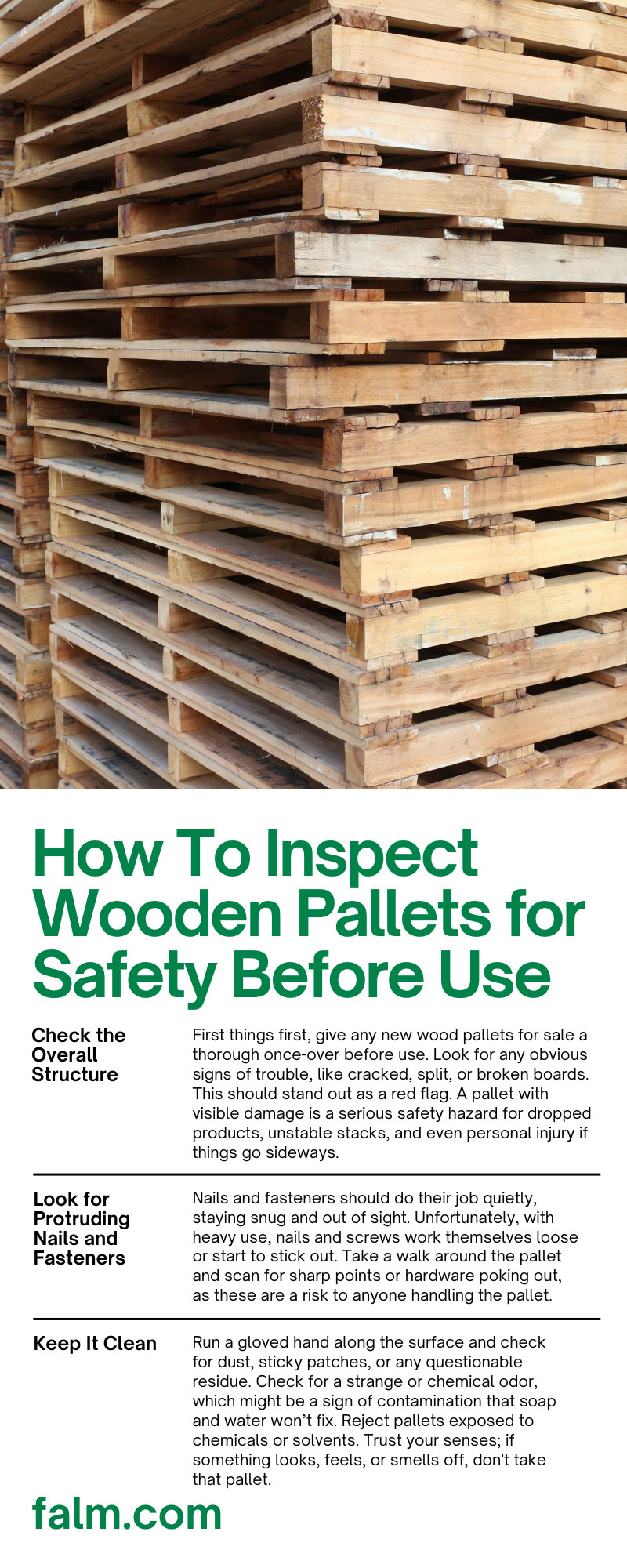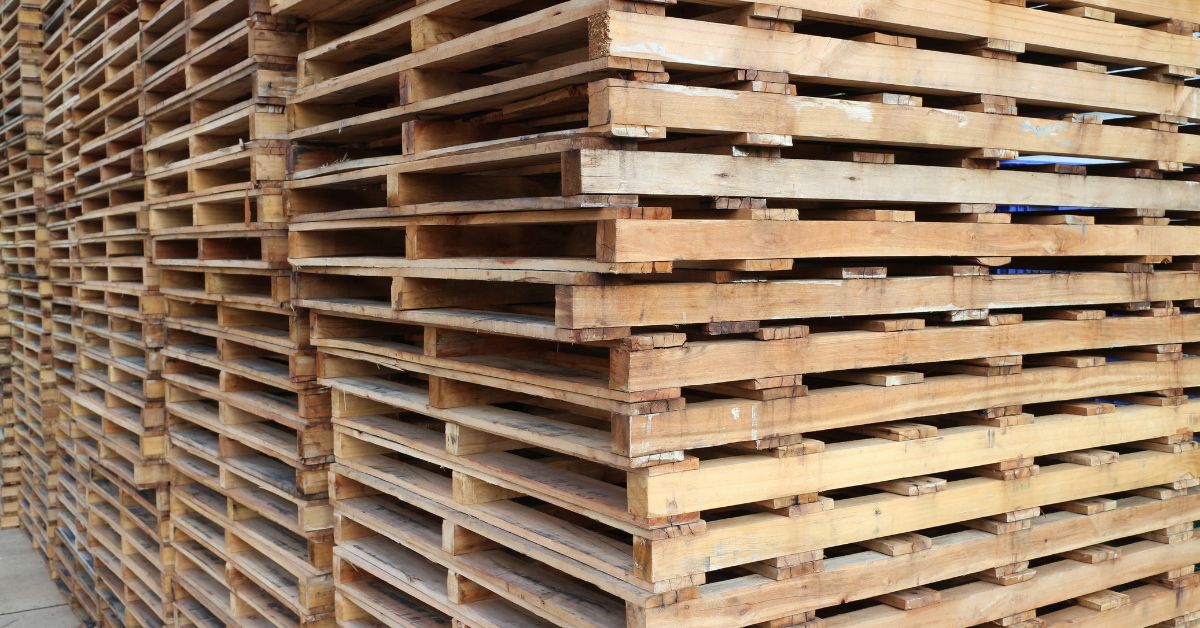- By First Alliance Logistics Management
- October 22, 2025
- Buying Pallets
Have you ever stopped to think about the humble wooden pallet? It’s the unsung hero of the shipping world, but a bad one can cause big problems in the form of damaged goods, workplace accidents, and major shipping delays. What if you could prevent these headaches with a simple, quick check? Learning how to inspect wooden pallets for safety before use can protect your products, your people, and your bottom line.
Check the Overall Structure
First things first, give any new wood pallets for sale a thorough once-over before use. Look for any obvious signs of trouble, like cracked, split, or broken boards. This should stand out as a red flag. A pallet with visible damage is a serious safety hazard for dropped products, unstable stacks, and even personal injury if things go sideways.
When you’re inspecting the pallet, gently push, pull, and rock it from side to side. You’re testing for wobble or instability, which can spell trouble on the warehouse floor or inside a delivery truck. An unstable pallet can shift or collapse during transit, putting your entire shipment (and your reputation) at risk.
Look for Protruding Nails and Fasteners
Nails and fasteners should do their job quietly, staying snug and out of sight. Unfortunately, with heavy use, nails and screws work themselves loose or start to stick out. Take a walk around the pallet and scan for sharp points or hardware poking out, as these are a risk to anyone handling the pallet.
Check that all the fasteners are present and tight. If a board wiggles or squeaks, it could mean hidden hardware issues, so look underneath and between boards. Tightening or replacing a nail on a wooden pallet prevents a whole shipment’s worth of headaches.
Keep It Clean
Wooden pallets live rough lives, seeing different warehouses, trucks, and work sites. Residues like oil, chemicals, or food waste can cling to the surface, posing real risks, especially when transporting sensitive items like food, clothing, or pharma products.
Run a gloved hand along the surface and check for dust, sticky patches, or any questionable residue. Check for a strange or chemical odor, which might be a sign of contamination that soap and water won’t fix. Reject pallets exposed to chemicals or solvents. Trust your senses; if something looks, feels, or smells off, don’t take that pallet.
Watch Out for Mold and Moisture
Moisture can seem harmless until you factor in mold, mildew, and the eventual weakening of the pallet. Mold can spread to your products, trigger allergies, and cause issues with regulators. Take the time to inspect corners, the underside of the pallet, and in between boards for any dark spots, fuzzy growth, or musty odors.
Humidity and poor storage leave pallets waterlogged. Press down firmly on a few boards. If there are soft or spongy areas, there is damage to the wood’s internal structure. Pallets with this type of damage are more likely to break and encourage pests. The best practice is to stick with pallets that are clean, dry, and mold-free to keep your shipments fresh and your customers happy.
Assess the Wood Quality
Some wood is tough, while some is brittle or requires more care. Beyond visible surface damage, check for signs of rot or decay. If you see small holes, crumbly sections, or unusual discoloration, that’s a no-go. Rot-filled pallets snap under pressure and fail suddenly, putting everything (and everyone) nearby at risk.
A small stray splinter here and there is normal, but pallets with large or excessive splintering need attention. Splinters snag products and packaging and turn simple lifting into a painful experience for your staff.
Know Your Load Capacity
New wood pallets for sale have limits, just like any piece of equipment. You’ll usually find a designated rating for maximum load weight, often provided by the manufacturer or your supplier. Double-check that this rating meets the demands of your shipment since overloading a pallet is asking for disaster.
Used or recycled pallets could have hidden weaknesses from years of use, exposure, or previous repairs. Check these pallets carefully and consider testing heavily used pallets with a gradual weight increase to see how they perform under pressure. Never exceed the specified wooden pallet load capacity. This is something your insurance provider (and your customers) will thank you for.
Shipping Internationally? Look for the Stamp!
If you’re shipping nationally, good pallet inspection still matters, but if your shipment will cross international borders, you need to be extra careful. Look for the “ISPM 15” stamp. This small mark assures customs officials that the pallet uses treated wood and meets global quarantine requirements.
Without the ISPM 15 stamp, your shipment might get stuck in customs limbo or, worse, rejected completely. That’s wasted time, extra costs, and major headaches. Always check for a clear, legible stamp, and never try to guess if a pallet is compliant if there is no mark. When in doubt, contact your pallet supplier for documentation or a compliant replacement.
Consider Fit for Purpose
Make sure each pallet actually works for your processes. New wood pallets for sale come in different sizes and designs, so don’t assume one size fits all. Double-check that your pallets are compatible with your forklifts, pallet jacks, and warehouse storage systems. Even a half-inch difference can make storage or moving a load a tricky task.
If you’re transporting food, beverages, or pharmaceuticals, check that your pallets meet hygiene and safety requirements, such as not undergoing previous chemical treatment, not having nails sticking out, and not displaying rough wood. For automated warehouses or facilities with robotic handling systems, a uniform pallet size and shape is a requirement. The right pallet saves time and reduces risk across your operations.
Safety and Sustainability Go Hand-in-Hand
Inspecting wooden pallets is better for the environment. By removing compromised pallets from your supply chain, you extend the lifespan of your inventory and reduce waste. Choosing high-quality recycled pallets from a reputable supplier lets you support sustainability without sacrificing performance.
Look for pallets with sustainability certifications like FSC (Forest Stewardship Council) for wood that comes from responsibly managed forests. Good inspections and good sourcing go together, making your operations both efficient and eco-friendly.
Your Partner for Safe and Reliable Pallets
Now that you know how to inspect wooden pallets for safety before use, you can keep your team safe and keep your business running efficiently. A quick pallet inspection catches potential problems before they happen. You can protect your products, and it only takes a few extra minutes, but the peace of mind is priceless.
Partner with First Alliance Logistics Management, the leading single-source wooden pallet supplier in the US. Get in touch with our team to secure safe, high-quality pallets for your business on time, every time. Let’s make pallet problems a thing of the past!


